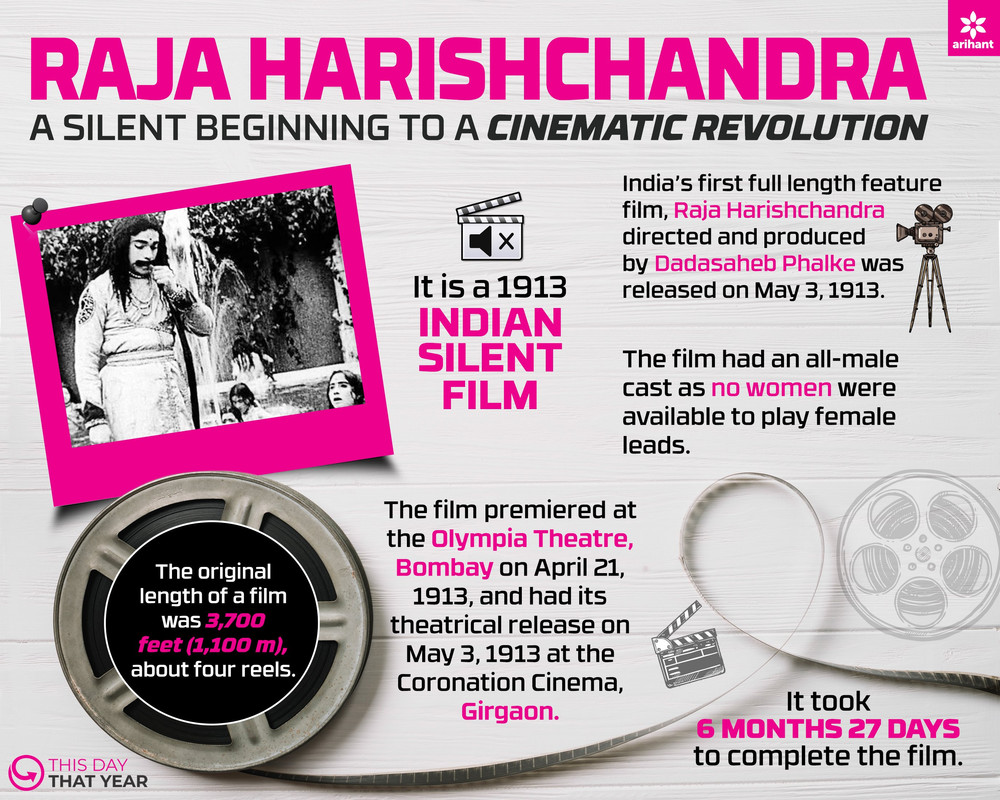The Making of ‘Raja Harishchandra’, India’s First Feature Film
SUKTARA GHOSHUPDATED:00H 23M AGO
5 min read
1.8K ENGAGEMENT
- fb
- t
- f
- w
3 May 1913 was a momentous day for what was then Bombay. One imagines the city grappling with the sweltering summer heat, but that didn’t stop people from queuing up for tickets at the Coronation Theatre in Girgaon to catch the first public show of India’s first feature film, Raja Harishchandra. The approximately 50-minute long silent film came with a film length of 3700ft (in four reels) and Marathi title cards. It was directed by Dhundiraj Govind Phalke - better known today as Dadasaheb Phalke, the father of Indian cinema.
Raja Harishchandra recounts the well-known mythology of a king who refuses to lie or deviate from his principles even when faced with the most extreme adversities, engineered to test his character by the sage Vishwamitra.
![]() A still from Raja Harishchandra.
A still from Raja Harishchandra.
The mythology might hold little interest for many today, but in a way, it echoes the indomitable spirit of the film’s maker. And Raja Harishchandra’s backstory makes it an enormously fascinating affair for movie lovers - even after 106 years after its release.
‘Raja Harishchandra’ is not only our first feature film. It was also truly an “Indian” one - the cast and crew being entirely from this country. Today, unfortunately, only the first and fourth reels of the film survives, preserved at the National Film Archive of India, Pune and on the internet.
- fb
- tw
A Pioneering Spirit
 Dadasaheb Phalke is the father of Indian cinema.(Photo courtesy: Facebook)
Dadasaheb Phalke is the father of Indian cinema.(Photo courtesy: Facebook)
Dadasaheb Phalke had the true spirit of a pioneer - and it’s curious how much his story resonates with that of another path-breaker, Satyajit Ray, who had similar skills and went through similar travails to make his first film, Pather Panchali, which took the world by storm in 1955.
Phalke dabbled in multiple professions - photography, printing, make-up, and even magic - before he turned to filmmaking after being veritably consumed by the silent film The Life of Christ (1902).
He quit his printing press job and convinced financiers to fund a trip to London where he would learn the art of movie-making. How did he convince them? By making a short film, ‘Birth of a Pea Plant’, that used stop-motion photography to capture the plant’s progress.
- fb
- tw
He went to London in 1912, where apart from training, he bought a Williamson camera, a printing machine, a perforator and raw film.
Back in India, Phalke wrote the screenplay of Raja Harishchandra and pledged his life insurance policies and sold his wife’s jewellery to raise money for the film.
Was it the end of his troubles though? Not by a mile.
 A still from Raja Harishchandra.
A still from Raja Harishchandra.
Also Read : Infographic: Dadasaheb Phalke, the Man Who Reinvented Storytelling
The Making of ‘Raja Harishchandra’
Even as he cast Dattatraya Damodar Dabke, a Marathi stage actor, to play the lead role of Raja Harishchandra, Dadasaheb Phalke reached the end of his rope trying to cast a woman for the role of Harishchandra’s wife, Taramati. Acting wasn’t considered to be a respectable profession those days, and Phalke even tried his hand at casting sex workers - and failed.
 Dattatraya Damodar Dabke and Anna Salunke in a still from Raja Harishchandra.
Dattatraya Damodar Dabke and Anna Salunke in a still from Raja Harishchandra.
Finally, he cast a male actor, Anna Salunke, who worked as a cook in a restaurant, for the role of Taramati. He cast his own son, Bhalchandra D Phalke as Lohitashwa, Harishchandra’s son.
- fb
- tw
Phalke set up a studio in Mumbai’s Dadar, where he shot a part of Raja Harishchandra. The film's outdoor scenes were shot in a village near Pune. It took Phalke seven months and 21 days to complete the film, during which his wife looked after all the needs of the cast and crew.
 A still from Raja Harishchandra.
A still from Raja Harishchandra.
Raja Harishchandra actually premiered on 21 April 1913 at the Olympia Theatre, Grant Road for the press and an invited audience, followed by the public premiere on 3 May. Later, the film was also screened in London in 1914.
This is how Dadasaheb Phalke promoted the film: “A performance with 57,000 photographs. A picture two miles long. All for only three annas.” He also preceded the film with a dance performance by two European girls for the first few days.
- fb
- tw
 An ad for Raja Harishchandra.(Photo courtesy: Twitter)
An ad for Raja Harishchandra.(Photo courtesy: Twitter)
‘Raja Harishchandra’ was an enormous box office success and ran for 23 days.
- fb
- tw
And thus began the journey of Indian cinema. We have travelled eons since then in terms of filmmaking for sure, but let’s not forget the first film and its maker who showed us the way.
Also Read : 7 Things You Should Know About the First Indian Talkie ‘Alam Ara’






























0